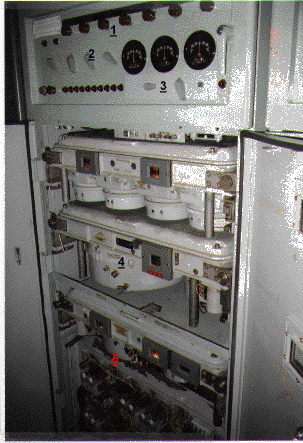
Servo motors drove the potentiometers. In an anti-aircraft problem the variables do not change too rapidly, so the mechanical speed limitations were not a problem. Components in this cabinet include:
- Knobs to input the offsets of the Missile Tracking Radar and the Target Range Radar
from the position of the Target Tracking Radar in North/South, East/West, Up/Down.
(All units in this computer are in the artillery's favorite unit, the yard.) - Switches to control the computer test modes and the computer test problem. The
computer was remarkably self checking.
- Power supply monitoring select switch. Black dials above show power supply voltage.
the long row of red lamps to the left help indicate op-amp zero set overload.
- The largest of these servo driven potentiometers is the time pot. On the same
shaft are "wipers" for about 8 variable resistors.
- In the cabinet to the right (behind the open door) are power supplies.
There was a stunning variety of voltages available to this computer
+70, +-100, +-250, +-320 volts come to mind, probably forgot a few.
(The +- 150 volts were reference voltages for full scale of most variables.
Max time was +100 volts, max distance was 100 volts, max speed was 100
volts, etc.) Most tubes used 12 volts AC to heat the filaments (the little
red glowing wires that heated the cathodes to emit the electrons).
Most tubes took 4 watts each just to heat the cathode. (More than your entire
transistor stereo when listing to gentle music.)
The cathode circuits of the operational amplifiers were supplied from -250 volts, and the anode ("plate") circuits were connected to +250 volts. If you went looking for a shock, you would not have to try too hard to get one. Most people working on this equipment never got bad shock (all shook up).